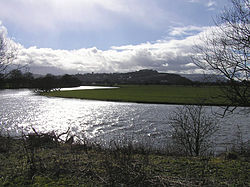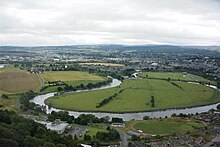| Forth | |
|---|---|
 The River Forth meanders through fertile farmlands near Stirling The River Forth meanders through fertile farmlands near Stirling | |
 Course of River Forth Course of River Forth | |
| Location | |
| Country | Scotland |
| Councils | Stirling |
| City | Stirling |
| Physical characteristics | |
| Source | Confluence of Duchray Water and the Avondhu River below Loch Ard |
| • coordinates | 56°10′52″N 4°24′30″W / 56.1810°N 4.4084°W / 56.1810; -4.4084 |
| • elevation | 33 m (108 ft) |
| Mouth | Firth of Forth, North Sea |
| • location | UK |
| • coordinates | 56°03′54″N 3°43′39″W / 56.0650°N 3.7275°W / 56.0650; -3.7275 |
| • elevation | 0 m (0 ft) |
| Length | 47 km (29 mi) |
The River Forth is a major river in central Scotland, 47 km (29 mi) long, which drains into the North Sea on the east coast of the country. Its drainage basin covers much of Stirlingshire in Scotland's Central Belt. The Gaelic name for the upper reach of the river, above Stirling, is Abhainn Dubh, meaning "black river". The name for the river below the tidal reach (just past where it is crossed by the M9 motorway) is Uisge For.
Name
Forth derives from Proto-Celtic *Vo-rit-ia (slow running), yielding Foirthe in Old Gaelic.
Course
The Forth rises in the Trossachs, a mountainous area 30 km (19 mi) west of Stirling. Ben Lomond's eastern slopes drain into the Duchray Water, which meets with Avondhu River coming from Loch Ard. The confluence of these two streams is the nominal start of the River Forth. From there it flows roughly eastward through Aberfoyle, joining with the Kelty Water about 5 km further downstream. It then flows into the flat expanse of the Carse of Stirling, including Flanders Moss. Just west of the M9, it is joined by the River Teith (which itself drains Loch Venachar, Loch Lubnaig, Loch Achray, Loch Katrine, and Loch Voil). The next tributary is the Allan Water, just east of the M9. From there the Forth meanders into the ancient port of Stirling. At Stirling the river widens and becomes tidal. This is the location of the last (seasonal) ford of the river. From Stirling, the Forth flows east, accepting the Bannock Burn from the south before passing the town of Fallin. It then passes two towns in Clackmannanshire: firstly Cambus (where it is joined by the River Devon), closely followed by Alloa. Upon reaching Airth (on the river's south shore) and Kincardine (on its north shore), the river begins to widen and becomes the Firth of Forth.
Settlements on the river
The banks have many settlements along them, including Aberfoyle, Gargunnock, Stirling, Fallin, Cambus, Throsk, Alloa, South Alloa, Dunmore, Airth, and Kincardine. Beyond these settlements, the water turns brackish, and is usually considered part of the Firth of Forth.
Port activities

In the sixteenth and seventeenth centuries, Stirling harbour was a busy port, with goods coming into Scotland and being exported to Europe. As a result, Stirling had very close ties with the Hansa towns, with Bruges in Belgium, and with Veere (known at the time as Campvere) in the Netherlands. After 1707, trade with America became the new focus, and so a lot of trade activity shifted from Stirling in the east to the port of Glasgow in the west. During World Wars I and II, Stirling harbour began thriving again: It became a gateway for importing supplies of tea into Scotland. After the wars, other trade activities slowly returned, but growth was slow because the harbour's owners levied heavy shore duties on shipping, making it less economically attractive to the few agricultural merchants who were based at Stirling. Today, Stirling's harbour has fallen into disuse, but there are plans to redevelop it.
Bridges
Main article: History of the Forth Crossing
Upstream from Stirling, the river is rather narrow and can be crossed in numerous places. (Crossing used to be more difficult before the installation of modern drainage works, because the ground was often treacherously marshy near the riverbank.) However, after its confluence with the Teith and Allan, the river becomes wide enough that a substantial bridge is required. At Stirling, there has been a bridge over the river since at least the 13th century, and it was the easternmost road crossing until 1936, when another road crossing was opened at Kincardine. The Clackmannanshire Bridge, just upstream of the Kincardine Bridge, opened on 19 November 2008. A railway bridge, the Alloa Swing Bridge, previously connected Alloa on the northern shore with Throsk on the southern shore. It opened in 1885 and was closed and mostly demolished in 1970: Only the metal piers remain.
Much further downstream, joining North Queensferry and South Queensferry, is another railway bridge, the famous Forth Bridge, which opened in 1890, and the Forth Road Bridge, which opened in 1964. To the west of the Forth Road Bridge is Queensferry Crossing, construction of which began in 2011: It finally opened on 4 September 2017.
List of bridges
There are a total of 24 bridges crossing the River Forth:
- Manse Road Bridge
- Footbridge near Doon Hill and Fairy Knowe
- Gartmore Forth Bridge
- A81 Road Bridge
- Disused Railway Viaduct near Gartmore railway station
- Cardross Bridge
- Poldar Bridge
- Bridge of Frew
- Gargunnock Bridge
- Old Drip Bridge
- New Drip Bridge
- M9 Road Bridge
- Old Mills Farm Footbridge and Pipeline
- Stirling Old Bridge
- Stirling New Bridge
- Stirling Forth Viaduct
- Cambuskenneth Footbridge
- A91 Road Bridge
- Alloa Swing Bridge
- Clackmannanshire Bridge
- Kincardine Bridge
- Queensferry Crossing
- Forth Road Bridge
- Forth Bridge
Islands
Main article: Islands of the ForthTwo islands (known as "inches") lie in the meandering estuarine waters downstream from Stirling: Tullibody Inch, near Cambus, and Alloa Inch, near Alloa. Both islands are fairly small, and are uninhabited.
On film and television
- River Forth (1956): A silent, 15-minute, black-and-white film that includes scenes of animals being herded through the streets.
- Britain's Lost Routes with Griff Rhys Jones (2012): Episode 3 explores the difficulties that cattle drovers might have encountered at Frew, shows cows being taken across the Auld Brig, and includes aerial shots.
- Sruth gu Sal, Episode 1: A 25-minute look at the Forth River (2 Nov 2009).
See also
- 275 kV Forth Crossing
- List of rivers of Scotland
- Rivers and Fisheries Trusts of Scotland (RAFTS)
- Shipping Forecast
References
- "River Forth Catchment Profile" (PDF). SEPA. Archived (PDF) from the original on 9 April 2017. Retrieved 8 April 2017.
- "OS 25 inch, 1892–1905". National Library of Scotland – Map Images. Ordnance Survey. Archived from the original on 30 November 2012. Retrieved 8 April 2017.
- Field, John:Place Names of Great Britain and Ireland, page 74. London, David & Charles, 1980
- "Interactive Map". RBMP. SEPA. Archived from the original on 9 April 2017. Retrieved 8 April 2017.
- The new statistical account of Scotland. Edinburgh and London: W. Blackwood and Sons. 1845. p. 397. Retrieved 8 April 2017.
- "Scotland in Europe". BBC History. Archived from the original on 11 April 2017. Retrieved 8 April 2017.
- Morris, David B. (1919). The Stirling merchant gild and life of John Cowane. Stirling: Morris, David B. pp. 195–210. Archived from the original on 29 September 2018. Retrieved 8 April 2017.
- Johnson, Simon (4 September 2017). "Queen opens new Forth crossing 53 years to the day after she opened old road bridge". The Telegraph. ISSN 0307-1235. Archived from the original on 22 May 2018. Retrieved 22 January 2018.
- "Aberfoyle, Manse Road, Forth Bridge". CANMORE. Retrieved 8 April 2024.
- "Gartmore, Forth Bridge". CANMORE. Retrieved 8 April 2024.
- "Cardross Bridge". CANMORE. Retrieved 8 April 2024.
- "South Flanders, Poldar Bridge". CANMORE. Retrieved 8 April 2024.
- Stewart, Charles (20 November 2019). "Frew would believe history of river crossing". Stirling Observer.
- "Gargunnock, Kirk Lane, Gargunnock Bridge". CANMORE. Retrieved 8 April 2024.
- "Drip Bridge, Old Bridge". CANMORE. Retrieved 8 April 2024.
- "Drip Bridge, New Bridge". CANMORE. Retrieved 8 April 2024.
- "Old Mills Farm Motorway Bridge". CANMORE. Retrieved 8 April 2024.
- "Old Mills Farm Footbridge And Pipeline". CANMORE. Retrieved 8 April 2024.
- "Stirling, Causewayhead, Bridgehaugh Road, Old Bridge". CANMORE. Retrieved 8 April 2024.
- "Stirling, Causewayhead Road, New Bridge". CANMORE. Retrieved 8 April 2024.
- "Network Rail completes £2.7m makeover of Forth Viaduct". Network Rail. 21 October 2022. Retrieved 8 April 2024.
- "Cambuskenneth Bridge". Gazetteer for Scotland. Retrieved 8 April 2024.
- "Alloa, Forth Rail Bridge". CANMORE. Retrieved 8 April 2024.
- "Name chosen for new Forth bridge". BBC News. 1 October 2008. Retrieved 8 April 2024.
- "Kincardine On Forth Bridge". CANMORE. Retrieved 8 April 2024.
- "Queensferry Crossing". CANMORE. Retrieved 8 April 2024.
- "Forth Road Bridge". CANMORE. Retrieved 8 April 2024.
- "Forth Bridge". CANMORE. Retrieved 8 April 2024.
- "River Forth". Moving Image Archive. Templar Film Studios. Archived from the original on 4 April 2017. Retrieved 4 April 2017.
- "Highland Cattle Drovers". BBC. Archived from the original on 9 August 2016. Retrieved 10 April 2017.
- "Sruth gu Sal". BBC Alba. Archived from the original on 18 September 2017. Retrieved 7 September 2017.
External links
KML file (edit • help) Template:Attached KML/River ForthKML is from Wikidata- Scottish Parliament: Forth Crossing Bill Committee Report, March 2010
- River Forth Crossing: House of Commons debates 18 May 2009
- British Waterways: River Forth
- Gazetteer for Scotland: River Forth
- SCRAN image: Steam dredger, River forth, late 19th Century
- Stirling Council: River Forth
- Forth Ports PLC
- Scottish Environment Protection Agency (SEPA): River level data for River Forth
- Forth Estuary Forum, a Scottish Charity
- Forth District Salmon Fishery Board
- River Forth Fisheries Trust
- Forth Bridges Visitor Centre Trust
- FYCA Alloa Swing Bridge
- RIVER FORTH (1956) FORTH – POWERHOUSE FOR INDUSTRY (1968) (archive films about the River Forth from the National Library of Scotland: Scottish Screen Archive)